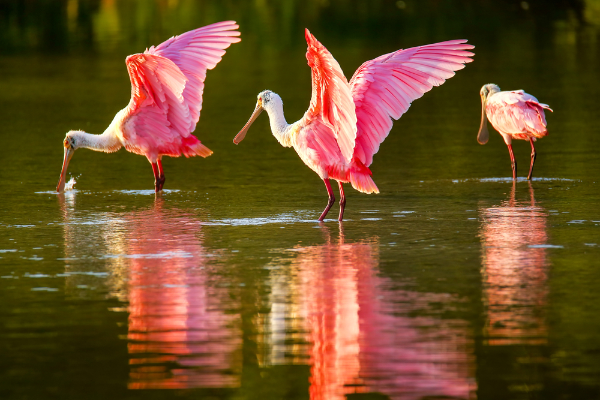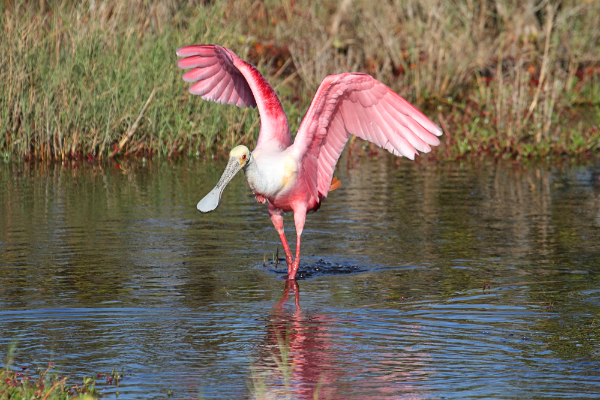The roseate spoonbill is a fascinating bird that can be found in the Southern United States and South America. This bird is known for its distinct pink coloration, which makes it easy to identify. Roseate spoonbills are interesting birds to watch, and they provide great opportunities for wildlife photography. If you’re lucky enough to see a roseate spoonbill in the wild, be sure to take advantage of the opportunity!

Roseate Spoonbill Description
The Roseate Spoonbill is a large bird that is native to the Americas. The Roseate Spoonbill gets its name from its distinctive bill, which is shaped like a spoon. The Roseate Spoonbill is pink in color, with a white belly and crimson wings. The Roseate Spoonbill is a wading bird, and can often be seen wading through shallow water in search of food. The Roseate Spoonbill eats mostly fish, but can also eat crustaceans and other small aquatic creatures. The Roseate Spoonbill is an important part of the ecosystem, as it helps to keep the population of fish and other aquatic animals in check. The Roseate Spoonbill is also a popular bird among birdwatchers, as it is relatively easy to spot and photograph.
Roseate Spoonbill Habitat
The Roseate Spoonbill is a large waterbird that is found in tropical and subtropical regions of the Americas. The Roseate Spoonbill get their name form their pink feathers and spoon-shaped bill. These birds are usually found near bodies of water such as swamps, marshes, and mangroves. Roseate Spoonbills use their long bills to filter food out of the water. The Roseate Spoonbill population has declined in recent years due to habitat loss and degradation. Roseate Spoonbills require large areas of undisturbed wetland habitat for feeding, nesting, and roosting. Wetland habitats are being lost at an alarming rate due to human activities such as development, agriculture, and pollution. Roseate Spoonbills are also hunted for their feathers, which are used in making native headdresses and other ceremonial items. As a result of these threats, the Roseate Spoonbill is considered to be a conservation-dependent species.
Roseate Spoonbill Diet
The Roseate Spoonbill is a large wading bird that is native to the Americas. The bird gets its name from its distinctive pink plumage and long, spoon-shaped bill. Roseate Spoonbills are found in marshy areas and coastal habitats, where they feed on small fish, crustaceans, and other aquatic invertebrates. The spoonbill uses its bill to sweep through the water, filtering out small prey items. Roseate Spoonbills typically eat 2-3 pounds of food per day. The bird’s diet changes seasonally, depending on what prey is available. In the winter months, Roseate Spoonbills may migrate to warmer areas in search of food.
Roseate Spoonbill Size
Roseate Spoonbills are a type of wading bird that is native to the Americas. They get their name from their long, spoon-shaped bill, which they use to filter food from the water. Roseate Spoonbills are pink or coral in color, with white feathers on their head and neck. They have a wingspan of approximately 2.5 feet and weigh between 3 and 5 pounds. Roseate Spoonbills typically live in coastal areas, where they can find plenty of food. They can also be found in some inland wetlands, though they are less common in these habitats. Roseate Spoonbills are social creatures and often form large flocks. However, they will also pair up during breeding season. Roseate Spoonbills typically lay 2-4 eggs per clutch, which hatch after about 28 days. The young birds fledge after about 8 weeks but continue to depend on their parents for food for several months. Roseate Spoonbills are not currently considered to be at risk of extinction, though their populations have declined in some areas due to habitat loss and degradation.

Roseate Spoonbill Lifespan
Roseate spoonbills are a species of wading bird native to the Americas, specifically Central and South America, and prefer warm, coastal environments. Roseate spoonbills are pink with white plumage, and they have a long, curved bill that is ideal for filter feeding. Their diet consists mostly of crustaceans, but they will also eat small fish, mollusks, and insects. Roseate spoonbills typically mate for life and reproduce once per year. The average lifespan of a Roseate spoonbill is 15-20 years in the wild and up to 30 years in captivity. Roseate spoonbills are not currently considered endangered, but their populations have declined significantly in recent years due to habitat loss and degradation. Conservation efforts are underway to protect this species and ensure its long-term survival.
Roseate Spoonbill Behavior
Roseate Spoonbills are a species of wading bird that is native to the Americas. They get their name from their distinctive pink plumage and long, spoon-shaped bill. Roseate Spoonbills are social birds that often gather in large flocks. They feed by wading through shallow water and sweeping their bills back and forth to filter out small fish and invertebrates. Roseate Spoonbills typically nest in trees or shrubs, but they will also nest on the ground if necessary. Roseate Spoonbill eggs are pale blue, and the chicks are born with gray down feathers. The down feathers gradually shed as the chicks grow, revealing their pink plumage. Roseate Spoonbills typically live for around 20 years in the wild. Roseate Spoonbill populations have declined in recent years due to habitat loss and degradation. However, Roseate Spoonbills are still fairly common in many parts of their range and are not currently considered to be at risk of extinction.
Roseate Spoonbill Speed
Roseate spoonbills are magnificent creatures. Their long, curved necks and pink feathers make them a striking sight, and their unique feeding habits make them a valuable asset to the ecosystem. Roseate spoonbills get their name from their distinctive bill, which is shaped like a spoon. This bill helps them to forage for food, scooping up small fish and other aquatic creatures. Roseate spoonbills are relatively slow-moving birds, but they have been known to reach speeds of up to 35 miles per hour when flying. When they are not feeding or flying, roseate spoonbills can often be seen resting in trees or on the ground. These beautiful birds are a joy to watch, and we are lucky to have them in our ecosystems.
Roseate Spoonbill Hunting
Roseate spoonbills are a type of bird that is hunted for their meat. The Roseate spoonbill has a long neck and bill, and is pink in color. They are found in the wetlands of North and South America. Roseate spoonbills eat crustaceans, mollusks, and small fish. Roseate spoonbill hunting season begins in October and ends in March. During this time, Roseate spoonbills can be found in the southern United States, including Florida, Louisiana, and Texas. Roseate spoonbill hunting is regulated by state and federal laws. Hunters must have a valid hunting license and must adhere to the bag limits set by each state. Roseate spoonbill meat is considered to be a delicacy by some, and is often used in stews or soups.
Conclusion
The roseate spoonbill is an interesting and beautiful bird that can be found in the wetlands of North and South America. These birds are fascinating to watch, and they play a vital role in their ecosystems. If you get the chance, be sure to visit a wetland area where you can see these amazing creatures up close.
Frequently Asked Question

